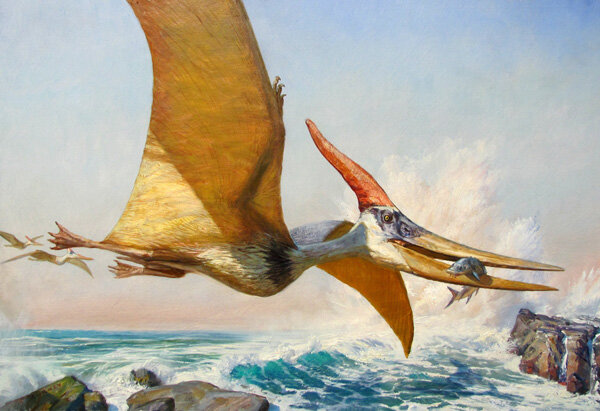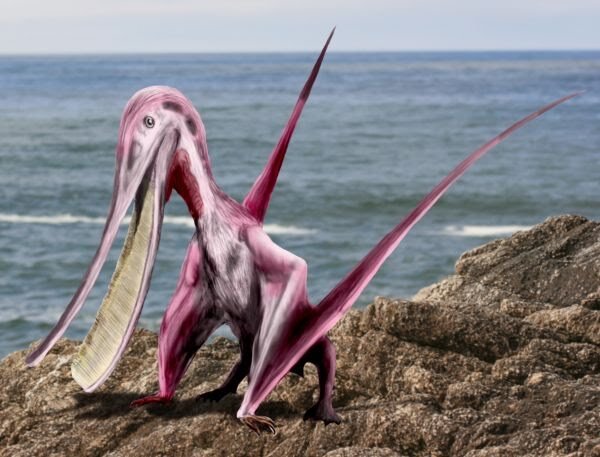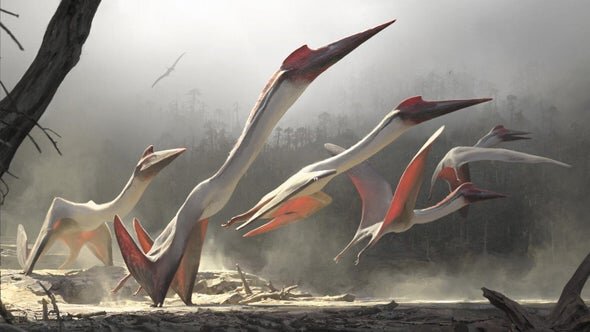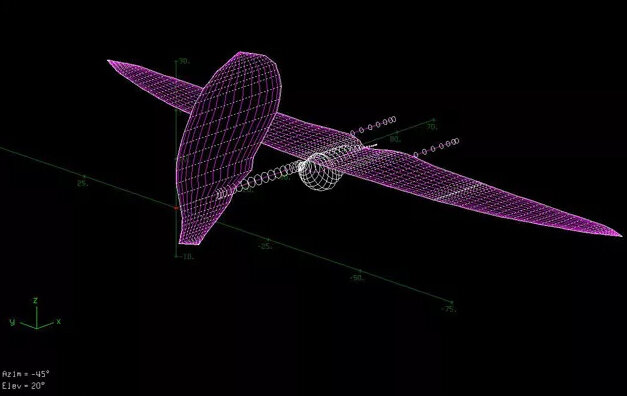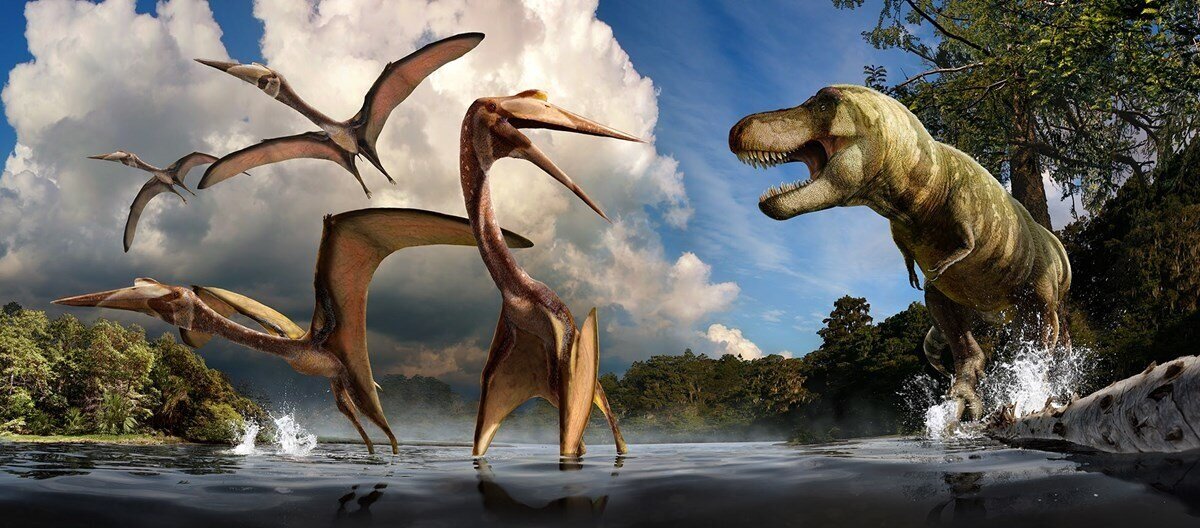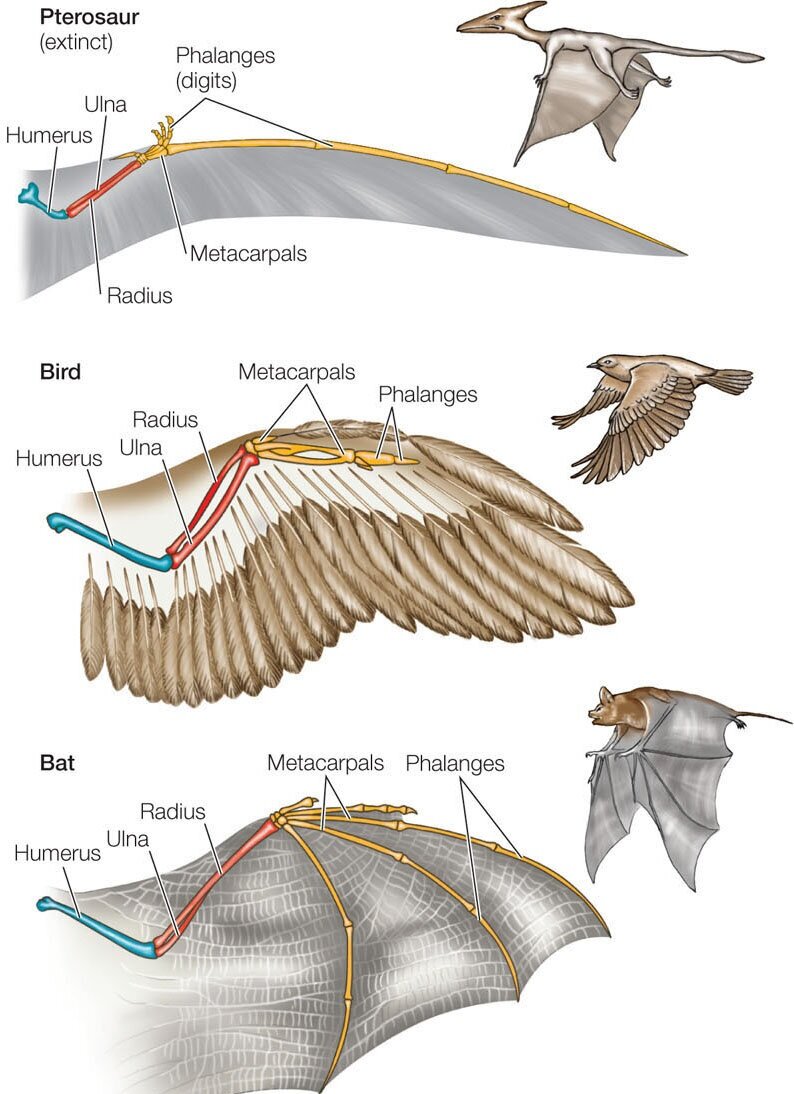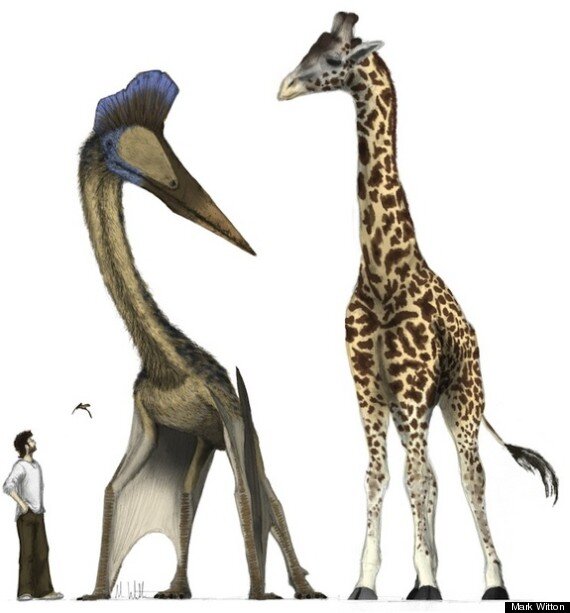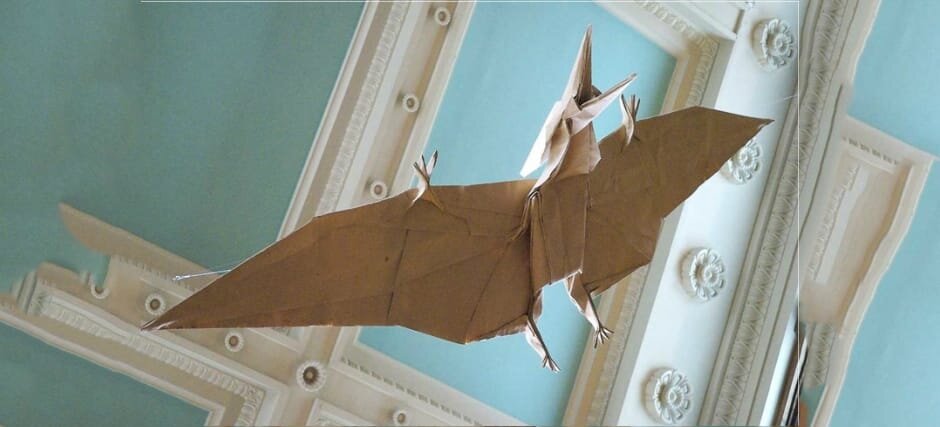From “space fossils” to foaming geysers, check out everything our young scholars discovered during the 2020-21 school year!
How did pterosaurs fly?
At the Science Mill, we love dinosaurs—we’re guessing you do, too! But in this blog, we want to show some love to pterosaurs: prehistoric flying reptiles that lived among dinosaurs, but were NOT dinosaurs.
In case you missed Part 1, pterosaurs ranged in size from sparrows to Cessna airplanes and had wild adaptations, including big heads, crazy crests and special membrane wings supported by super-long 4th fingers. What’s not to love?!
If dinosaurs ruled the Earth, pterosaurs definitely ruled the skies. But how they flew is a mystery paleontologists are still piecing together. You can try flying as a pterosaur in Jurassic Flight 4D, the Science Mill’s new 4D virtual reality experience! To celebrate its opening, join us Saturday, May 29 for Jurassic Experience, a day of dino-themed activities and special screenings of Flying Monsters, which features some of the paleontologists in this blog.
(artist: Chase Stone)
How did pterosaurs fly?
This is one of the big debates about pterosaurs: were all of them really able to fly—even the giraffe-sized species? This is where mathematics and computer models come in.
One computer simulation, developed by paleontologist Sankar Chatterjee and his team at Texas Tech University, suggests that an animal the size of a fighter jet would need a runway. “It probably had to find a sloping area like a riverbank,” explains Dr. Chatterjee, “then run quickly on four feet, then two, to pick up enough power to get into the air.” Once in the air, it was a graceful if frightening sight. “This animal probably flew like an albatross or a frigate bird in that it could soar and glide very well.”
Paleontologist Michael B. Habib and others have a different theory, based on computer simulations of pterosaurs’ launch power—no runway needed. “Flying animals do not flap their way into the air,” notes Dr. Habib. Instead, takeoff starts with a powerful jump, and four-limbed pterosaurs had double the power. “The legs would have pushed first, followed by the arms, for a perfect one-two push-off.” Some have compared the move to pole-vaulting.
(credit: Julia Molnar, via Scientific American)
But what about those enormous heads? If pterosaurs flew with their wings angled forward, as calculations by Dr. Colin Palmer and his team suggest, their big heads would be balanced. New fossils offer additional clues. CT scans of a pterosaur vertebrae recently revealed a strength-building secret: a “tube within a tube” structure supported by spokes, similar to a bicycle wheel. Paleontologist Cariad Williams and her team calculate that for a pterosaur with a 4-foot neck, adding just 50 spokes to its vertebrae would allow it to lift 90% more weight—roughly equal to picking up prey that weighed 24 pounds.
Are there pterosaurs living today?
No—pterosaurs went extinct at the end of the Cretaceous period. While birds evolved from dinosaurs, pterosaurs have no living descendants. They do, however, have mechanical relatives!
Experimental designs for Pterodrone (images: Brian Roberts)
Dr. Chatterjee and Rick Lind, an aeronautical engineer, teamed up to create a drone inspired by pterosaurs’ unique flying adaptations. Named “Pterodrone,” the drone’s design includes membrane-inspired morphing wings and an adjustable crest in the front. The features make the drone a more versatile flier in tight spaces. In the future, they hope to add the pterosaurs’ ability to walk and possibly sail.
TRY IT AT HOME OR SCHOOL
Animal Design Challenge
Research on pterosaurs helped Dr. Chatterjee and Dr. Lind design a new drone. Their work used biomimicry: an approach to technological innovation that draws ideas from nature. To experiment with biomimicry, try this Animal Design Challenge alone, with a partner or with a group!
Supplies
Slips of paper, index cards or Post-its (enough for each participant to get two)
Pencils or pens for writing
Colored pencils, crayons or markers for drawing
Dr. Chatterjee with a skeleton reconstruction of the pterosaur that inspired the Pterodrone’s design. (credit: AP Photo/Artie Ummer)
On half the cards, write an animal—one per card. (Prehistoric animals are fair game!)
On the other half of the cards, write a short everyday problem—one per card. (EX: Keep construction workers safe; chop up vegetables; carry a heavy bag)
Mix up the animal cards and have each person take one; mix up the problem cards and have each person take one of those, too.
Brainstorm! How could your animal inspire a solution to your problem? Maybe something about their body? How they move, or where they live? Jot down your ideas.
Design! Pick one of your ideas and sketch out a prototype for a new product or system. Try to show how it would work.
If you’re working solo, pick another animal card and see if you can add on to your prototype; or pick another problem card, too, and start again!
If you’re working with a partner or group, share your ideas. After seeing everyone’s animals, problems and prototypes, what new combinations do you see for biomimicry inspiration?
Keep observing and brainstorming! Study plants and animals outside, a pet at home—who knows where your next big idea might come from?
CAREER CONNECTION
“An aircraft based on pterosaur concepts may be able to fly to a rooftop then walk under an overhang to mount a sensor in a dark corner.” — paleontologist Sankar Chatterjee and aeronautical engineers Rick Lind and Brian Roberts, on their inspiration for Pterdrone
MORE TO EXPLORE
Explorer Zone Episode 4: Masters of Disguise
Labs on the Go: Bug Inspired Biomimicry (Grades 6-8)
Check out our new Labs on the Go series for Grades K-8: Each Lab combines hands-on STEM activities with video “field trips” that show science in action. Everything you need ships directly to your classroom and is supported through an easy-to-navigate online learning system!
Is a pterosaur a dinosaur?
Do you have a favorite dinosaur? Celebrate it on May 18—International Dinosaur Day! (In fact, dinos are so big, they get two holidays: June 1 is International Dinosaur Day, too.)
Do you also have a favorite pterosaur? If you’re thinking, “What’s a pterosaur?” or “Isn’t that a dinosaur?”, read on! This is Part 1 of a two-part feature on pterosaurs, some of the weirdest, coolest creatures to ever fly. At the end of this post, you’ll find a DIY activity to make your own pterosaur!
Flocks of pterosaurs will (virtually) take to the sky this summer in Jurassic Flight 4D, the Science Mill’s new 4D virtual reality experience that lets you fly as a pterosaur through a world of dinosaurs. Join us Saturday, May 29 for Jurassic Experience, a day of dino-themed activities and the exhibit’s grand opening.
(artists: Julius Csotonyi and Alexandra Lefort, via National Park Service/ Big Bend National Park)
What’s a pterosaur?
Pterosaurs (the “p” is silent) were flying reptiles that lived 228 to 65 million years ago. They were the world’s first flying vertebrates, reaching new heights millions of years before modern birds and bats. Pterosaurs didn’t just leap or glide between heights, the way some reptiles do today. They were true fliers who could create lift by flapping their wings—what scientists call “powered flight.” (But there’s debate about how they flew; more on that in Part 2!)
“Pterosaur” isn’t one kind of animal: it’s actually a whole bunch of related species. The general name we use comes from Pterosauria, the scientific order that groups together these flying reptiles. For comparison, another order is Primates, which groups together apes, lemurs, lorises, tarsiers, monkeys and humans.
Are pterosaurs a kind of dinosaur?
Nope, pterosaurs are NOT dinosaurs. They are cousins, who share a common ancestor but evolved into distinct groups. That might seem confusing: pterosaurs lived at the same time as dinosaurs and, well, don’t they look like dinosaurs?!
Scientific classifications go more than skin deep; they’re based in a careful study of anatomy that helps scientists better understand and organize both living and extinct creatures. Part of what separates dinosaurs from pterosaurs are their hip and arm bones. All dinosaurs have a hole in their hip socket and a crest on their upper arm bone; all pterosaurs do not. This video with paleontologist Danny Barta helps explain.
What did pterosaurs look like?
Pterosaur species came in every size, “from that of a sparrow to a Cessna plane with a wingspan of 35 feet,” describes Sankar Chatterjee, a paleontologist at Texas Tech University. Kepodactylus, the pterosaur you’ll fly as in Jurassic Flight 4D, had a wingspan around 8 feet.
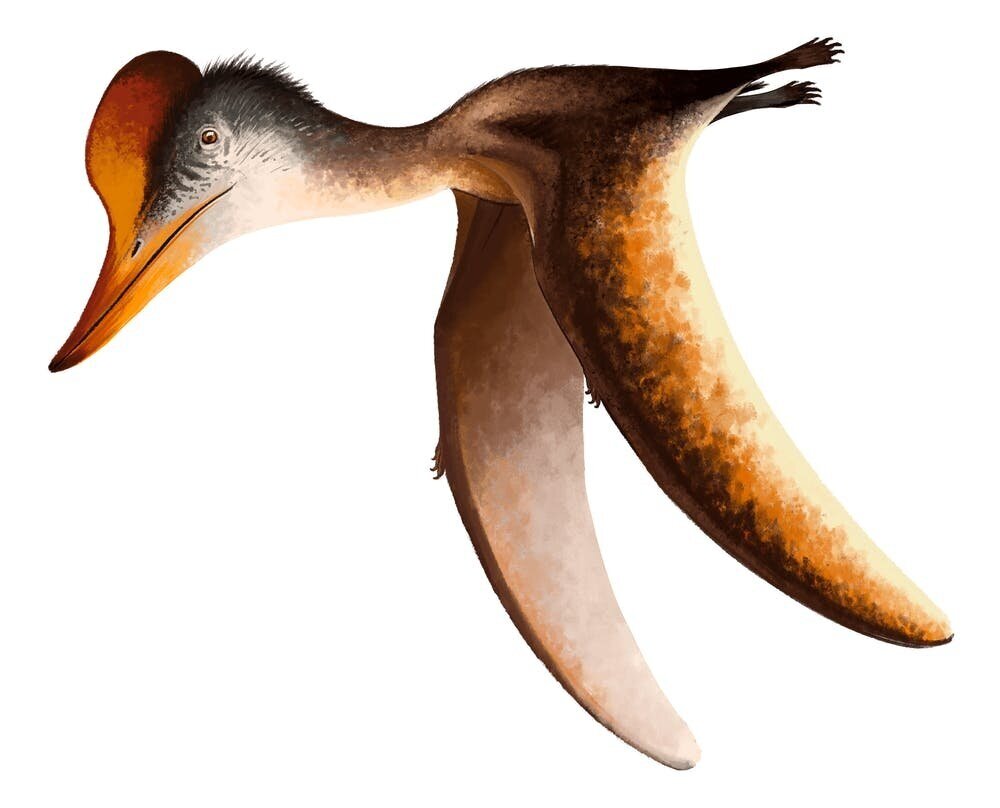
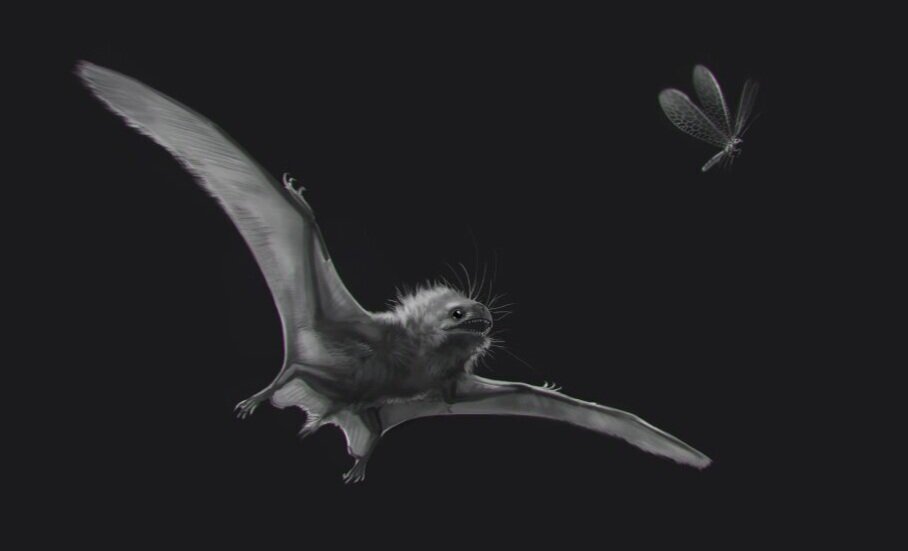

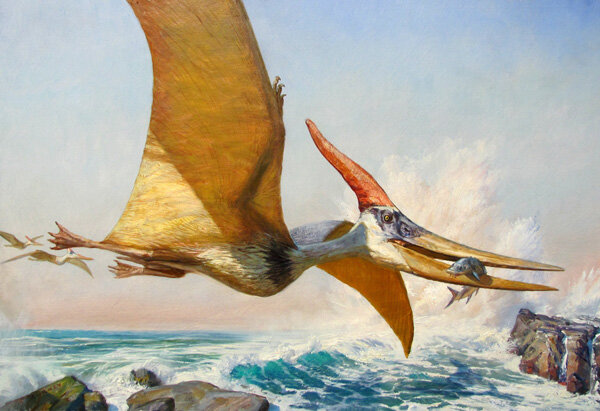
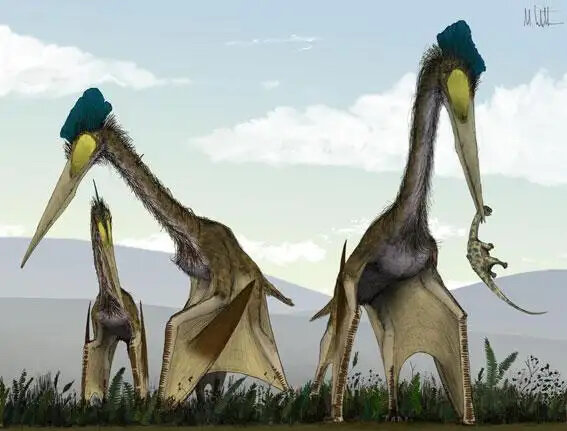
Pterosaurs share some very strange anatomical features. “They evolved some of the most extreme adaptations of any animal,” says paleontologist Michael B. Habib.
(source: MacMillan Learning)
Looooong “wing fingers”: Unlike birds or bats, pterosaur wings ran along the sides of their bodies and were held up by a super-long fourth digit—the equivalent of our ring fingers. (Pterodactylus, one of the most famous pterosaurs, is actually named for this feature: ptero = wing and dactyl = finger.)
Shape-shifting wings: Sandwiched inside their wing membranes were layers of blood vessels, muscles and actinofibrils—chord-like fibers that made the membrane rigid yet flexible. One theory is that the muscles and fibers may have allowed pterosaurs to change the shape of their wings in flight.
Feathery fur?: Pterosaurs’ bodies were covered in pycnofibers—scientists aren’t sure if this fuzz was more like fur, feathers (think: baby chick) or hair. The covering probably helped pterosaurs control their body temperature.
How would you measure up against Quetzalcoatlus? (artist: Mark Whitton)
Crazy crests: Many pterosaur species had crests on their heads. Some crests were fleshy, some bony and others had a membrane “sail.” Crests might have helped regulate heat or balanced out long jaws. Most likely, they served to attract a mate. Scientists think some crests were brightly colored for extra flair!
Long necks + BIG heads: Pterosaurs had oddly proportioned bodies with big heads. Some species’ skulls and necks were well over half their body length. Mega-sized Quetzalcoatlus, found in Texas, had a head and neck that made up 75% of its length, with jaws twice the length of a T.rex’s!
How did an animal the size of a giraffe, with an enormous head, manage to fly? ...Or did it? Find out in Part 2!
TRY IT AT HOME OR SCHOOL
Fold an origami pterosaur
Make a paper pterosaur that shows off some of their extreme adaptations: big heads with long jaws, crests and, of course, those amazing wings. You’ll need a square piece of paper to get started. Click the links below to download instructions.
12-step pterosaur (designed by Nick Robinson)
25-step pterosaur (designed by Fernando Gilgado Gomez)
CAREER CONNECTION:
“The cool thing about origami is that it is a very mathematical art...You can do things with pure art, you can do things with pure math, but if you put them together, you get far more satisfying results than either one alone.” - Robert Lang, physicist and origami artist
MORE TO EXPLORE
Learn how Robert Lang used artistry and computer programming to design a life-size origami Pteranodon for the Redpath Museum in Montreal!
13 ways to help butterflies and bees
April 22 is Earth Day! To celebrate our planet’s amazing pollinators, we’ve put together a list of 13 ways you can help butterflies and bees. For more ideas, visit our blog post “Make Your Yard a Pollinator Pit Stop” for beginner-friendly plant guides and citizen science projects.
Join the Science Mill’s Butterfly Bonanza (+ Bats & Bees) on Saturday, April 24 from 10am-2pm for up-close encounters with pollinators and all-ages activities.
13 ways to help butterflies and bees:
Plant native species with a variety of shapes, colors and blooming seasons
Add a border of native flowers around your vegetable garden
To sync with pollinators, garden by early spring and don’t clip late blooms in the fall
Give thirsty bees a drink (but it’s best to avoid sugar water)
Find places in your yard to protect bare soil and brush for native bees to nest
Build a bee condo or bee hotel for native bees
Avoid chemicals on your yard and when you buy plants and seeds (some are pretreated)
Support the reduced use of neonicotinoid pesticides that harm bees
Rethink weeds: dandelions offer bees some of spring’s first nectar
Rethink lawns: non-flowering grass + little plant diversity = pollinator dead zones
Relocate beehives with professional help instead of exterminating
(Visit the Science Mill’s Butterfly Garden to see these beautiful blooms and many others!)



